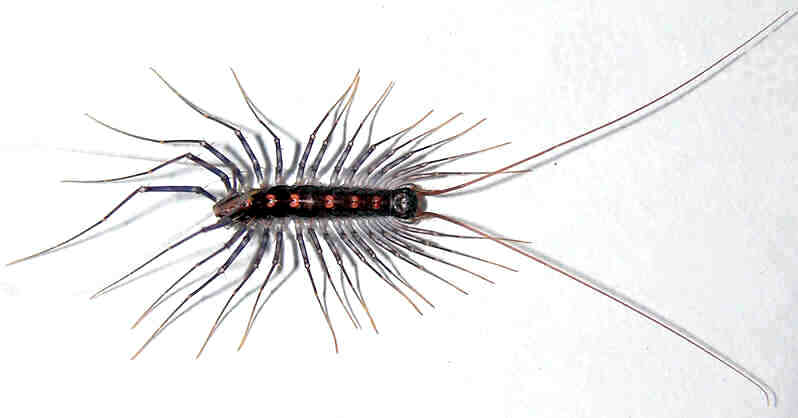|
Differences between
Centipedes (Chilopoda) and Millipedes
(Diplopoda) |
|
Centipedes |
Millipedes |
|
One pair or two legs
on each segment; adult leg no. ranges from 30 (15 pairs) to 382 (191
pairs) on Gonibregmatus plurimipes Chamberlin in Fiji
(Geophilomorpha: Gonibregmatidae). |
Two pairs or four legs
on most segments because these are really "diplosegments" formed by
fusion of adjacent somites in the embryo; legs always on metazonite,
representing caudal of fused somites; adult leg no. ranges from 22
(11 pairs) to 750 (375 pairs) on Illacme plenipes Cook and
Loomis in San Benito Co., California (Siphonophorida:
Siphonorhinidae). |
|
Legs extend laterad
and are clearly visible on sides of body; this position provides
little support and the body is carried low to
substrate. |
Legs extend at most
only slightly laterad and are only partly visible on sides of body;
this position provides strong support, and the body is carried high
off substrate. |
|
Last legs extend
backwards behind the body and are not used for
locomotion. |
Last legs extend
sideways parallel to other legs. |
|
Legs articulate
laterally with body. |
Legs articulate
midventrally with body; as they provide the pushing/burrowing power,
this position allows for the longest possible legs and greatest
power with least lateral extension, minimizing chance that legs may
be broken in the narrow spaces that millipedes
inhabit. |
|
Flexible,
dorsoventrally flattened arthropods (except Scutigeromorpha, which
is not flattened). |
Relatively inflexible
arthropods with variable body forms that, in general, are
subcylindrical. |
|
Almost exclusively
carnivores. |
Primarily
detritivores, though carnivory occurs occasionally in a few species;
most species in subterclass Colobognatha have long, narrow,
"sucking" mouthparts, food source and method of feeding unknown;
millipedes are ecologically important in the fragmentation of leaf
litter, which facilitates microbial decomposition and soil nutrient
cycles. |
|
Adapted for speed
except for representatives of the Geophilomorpha, which move slowly
and burrow. |
Primarily slow moving
arthropods adapted for burrowing and 3 dfferent burrowing mechanisms
are known; some species have lost this ability and are surface
active, while others are too thin and weak to burrow and inhabit
existing cracks and crevices. |
|
Adults vary in length
from 10-270+mm (1/2-10 ½ in.); largest sp. is Scolopendra
gigantea in northern South America; largest North American sp.
is S. heros, occurring from Arkansas/Missouri to
Arizona and northern Mexico (ca. 153 mm, 6 in). |
Adults vary in length
from 3-270+mm; longest sp. is Archispirostreptus gigas, in
Africa; longest North American sp. is Paeromopus paniculus in
Yosemite National Park & vic., California (160 mm, 6 ½
in.). |
|
Have prehensors
("poison claws") under head with which they kill prey, and large
species can inflict a painful bite on man; they are actually
modified legs and appendages of the first segment and are not true
mouthparts. |
Lack structures to
bite, pinch, or sting, and are harmless to man, although defensive
secretions burn if get into eyes; a few large species in neotropics
can squirt defensive secretions a couple of feet and have blinded
chickens and dogs. |
|
Occur in all habitats
and are prominent in deserts and arid environments. |
Occur primarily in
moist deciduous forests because most species lack a waxy cuticle as
a dessication barrier; some species occur at high elevations in
"alpine" environments and a few thrive in deserts. |
|
Spiracles located
laterally (middorsally in Scutigeromorpha); in some forms they are
valvular and can be closed. |
Spiracles located
ventrally; they are never valvular and cannot be
closed. |
|
"Opisthogoneate";
reproductive tracts open at caudal end of body. |
"Progoneate";
reproductive tracts open near anterior end of body, specifically on
segment 3; in most millipedes (infraclass Helminthomorpha)
copulatory structures in males located caudal to seg. 3, either on
seg. 7 or segs. 7 & 8. |
|
Males do not possess
modified legs for reproduction. |
In subclass
Chilognatha, males possess modified legs; in infraclass Pentazonia
these involve 1-(?)3 pairs of legs at caudal end called "telopods"
that function either to clasp female during reproduction or deposit
spermatophore directly in female openings; in infraclass
Helminthomorpha insertion is accomplished by "gonopods" on segment
7; depending upon the order either the anterior leg pair on seg. 7,
or both pairs on seg. 7, or the posterior pair on seg. 7 and the
anterior pair on seg. 8 are so modified. |
|
Primarily use
prehensors for defense; also employ aposematic coloration,
luminescence, and some species, especially scutigeromorphs, can
autotomize legs; some species produce defensive
secretions. |
Primarily employ
defensive secretions from segmental defensive glands that open
laterally (middorsally in one family) [not all families have
defensive glands]; secretions contain variety of noxious chemicals
(quinones, terpenoid compounds, etc.) and one order, Polydesmida,
produces cyanide; also employ defensive posture of coiling into
protective spiral and in some orders a perfect ball or sphere with
head in center; also employ aposematic coloration to warn of toxic
defensive secretions and species of genus Motyxia in southern
California are bioluminescent. |
